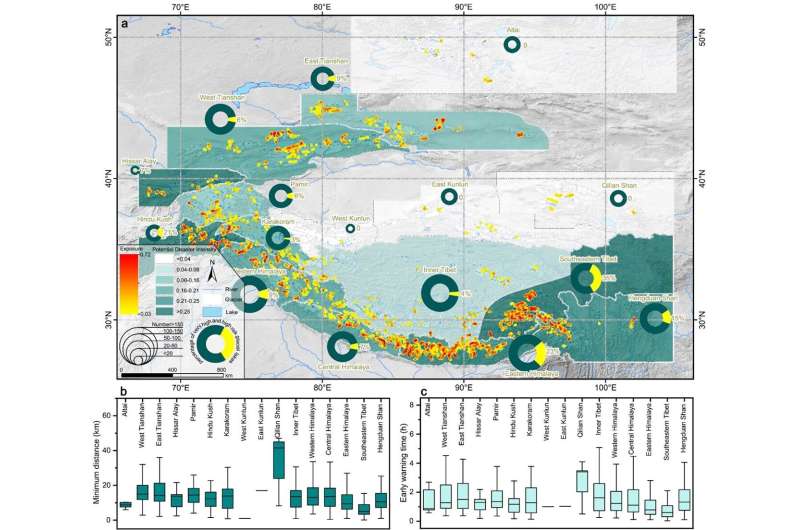This article has been reviewed according to Science X's editorial process and policies. Editors have highlighted the following attributes while ensuring the content's credibility:
fact-checked
peer-reviewed publication
proofread
Researchers study the risk of glacial lake outbursts in the Third Pole

The Third Pole, which spans the Tibetan Plateau and the surrounding Himalayas, Hindu Kush, and Tianshan Mountain ranges, is extremely vulnerable to the effects of climate change. Warming temperatures and altered rainfall patterns have caused more than 10,000 glaciers in the region to retreat over the past three decades, facilitating the formation of thousands of glacial lakes.
Though they appear harmless, these water bodies have tremendous destructive potential, particularly due to their ability to cause glacial lake outburst floods (GLOFs). When triggered by events like glacier collapse, snow avalanches, landslides, or the collapse of natural dams, glacial lakes can release vast volumes of water swiftly, leading to destructive GLOFs.
Since GLOFs pose an immense threat to communities and industries located near glacial lakes at the Third Pole, efforts have been made to understand their triggers and assess their risks with the intention of facilitating preventive decision-making.
Unfortunately, the methods used for assessing these risks have been significantly varied across these studies. For example, the number of glacial lakes reported varied in number from 10,000 to 30,000 in the 2015–2020 period, depending on the definition used. These inconsistencies make it difficult to create a reliable dataset for further data analysis and GLOF risk assessment.
Against this backdrop, a research team headed by Associate Professor Weicai Wang from the Institute of Tibetan Plateau Research, Chinese Academy of Sciences, China, decided to carry out a more detailed analysis of GLOF risks in the Third Pole. The study, published in Nature Communications on December 12, 2023, underscores the need for urgent action and regional cooperation for the economically disadvantaged and highly vulnerable regions in the Third Pole.
To this end, the researchers first obtained satellite images from the Sentinel-2A and Sentinel-2B missions between 2018 and 2022. Then, they identified and classified all glacial lakes based on their position and topological characteristics in relation to their source glacier. This updated inventory of glacial lakes, coupled with earlier datasets, enabled them to analyze the changes in this region over the past decades, revealing a worrisome continuous expansion of glacial lakes.
Further, they analyzed changes in GLOF activity by consolidating datasets of GLOF events in the Third Pole, tracing back as far as 1900. Their findings, in contrast to previous studies, revealed a worrisome trend, indicating an increase in GLOF occurrences from an average of 1.5 events annually during 1981–1990 to 2.7 events during 2011–2020.
The researchers noted that the expansion of glacial lakes and the appearance of new ones will likely lead to an increase in the number of GLOFs per year in the future, underscoring the need for developing better analytical methods and datasets to stay one step ahead of potential disasters.
Finally, the team analyzed the susceptibility to GLOFs in 5,535 glacial lakes and identified 1,499 of those with a high potential for outburst floods. The researchers also investigated the "potential disaster volume" based on GLOF simulations of these high-risk lakes. The results were concerning, to say the least.
"Approximately 55,808 buildings, 105 existing or planned hydropower projects, 194 km2 of farmland, 5,005 km of roads, and 4,038 bridges are threatened by the potential GLOFs," states Dr. Wang. "Moreover, by utilizing regional population distribution data, we estimated that roughly 190,000 lives are directly exposed within the GLOF paths," he explains.
Overall, these findings are concerning, especially for countries exposed to GLOFs in the Third Pole, especially China, Kazakhstan, Nepal, India, and Pakistan. "Our findings underscore the significant challenges posed by the substantial potential disaster volumes in these economically disadvantaged and highly vulnerable regions," says Dr. Wang.
"Considering the projected extension of GLOF threats under future climate change scenarios, it is crucial for the relevant nations surrounding the Third Pole to recognize the urgency of addressing GLOF threats and to promote regional cooperation."
Going ahead, this work will hopefully lead to better risk management strategies for GLOFs and foster cooperation between countries in the Third Pole. In addition, and perhaps most importantly, these findings should also raise awareness of the many ways in which climate change threatens our lives.
More information: Taigang Zhang et al, Enhanced glacial lake activity threatens numerous communities and infrastructure in the Third Pole, Nature Communications (2023). DOI: 10.1038/s41467-023-44123-z
Journal information: Nature Communications
Provided by Cactus Communications




















